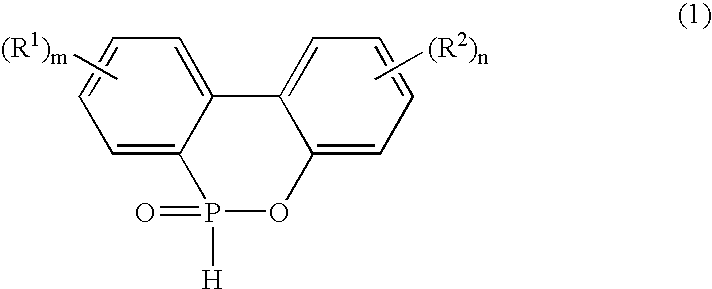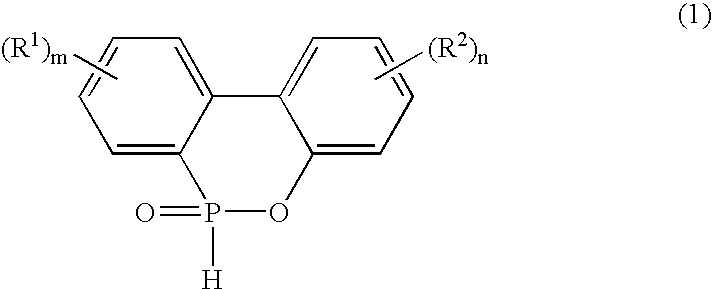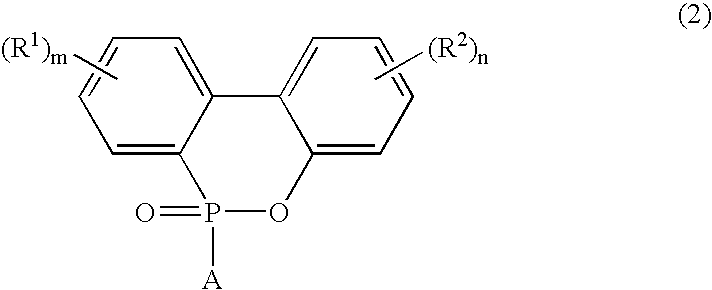Thermoplastic Resin Composition For Masterbatches, Method Of Producing Molding Material Thereof, And Thermoplastic Resin Composition Using Them And Method Of Production Thereof
a technology of thermoplastic resin and masterbatches, which is applied in the field of thermoplastic resin composition for masterbatches, method of producing molding materials thereof, and thermoplastic resin composition using them and method of production thereof, can solve the problems of reducing processibility or workability, bleedout of flame retardants or darkening of thermoplastic resin composition products, and inability to obtain high-phosphorus-content thermoplastic resin compositions, etc., to achieve easy and uniform mixing, easy chip shape adjustment, and high phosphorus conten
- Summary
- Abstract
- Description
- Claims
- Application Information
AI Technical Summary
Benefits of technology
Problems solved by technology
Method used
Image
Examples
reference example 1
(Synthesis of Organophosphorus Compound)
[0137] To 1000 parts of crude orthophenylphenol (OPP) with a purity of 95% was added 4.9 parts of toluene. The mixture was stirred at room temperature for about one hour, and the supernatant was removed. To a reaction pot were added 1000 parts of orthophenylphenol and 1009 parts of phosphorus trichloride (1:1.25 in molar ratio), mixed at room temperature for one hour, and heated to 150° C. over five hours so that hydrogen chloride was generated. Thereto was added 5.9 parts of zinc chloride and allowed to react at 200° C. for four hours to obtain 6-chloro-(6H)-dibenzo-(c,e)(1,2)-oxaphosphorine (DOP-X).
[0138] To the resulting DOP-X was added 500 parts of toluene and stirred at room temperature for about one hour, and the supernatant was removed for purification of DOP-X.
[0139] Thereto was also added 77 parts of water such that the molar ratio of the water to the orthophenylphenol was 1:1, and 1000 parts of toluene was further added. Hydrolys...
example 1
(Preparation of Thermoplastic Resin Composition for Masterbatches (II))
[0143] To a stainless steel autoclave equipped with a stirrer, a distillation column and a pressure regulator were added 832 parts of terephthalic acid, 1000 parts of the organophosphorus compound (GHM) produced in Reference Example 1, which was in a 50% ethylene glycol solution and for forming a polymer with a phosphorus content of 30000 ppm, and 184 parts of ethylene glycol and further 0.62 parts of antimony trioxide and 3.26 parts of triethylamine. The mixture was subjected to esterification under a gauge pressure of 2.5 kg / cm2 at 245° C. for two hours while water produced by the esterification was successively removed. The reaction system was subsequently heated to 275° C. in one hour while the pressure of the system was gradually reduced to 0.1 mmHg. Under these conditions, condensation polymerization was performed until the melt viscosity reached 3500 poise (275° C.).
[0144] The melt was then discharged f...
example 2
(Preparation of Thermoplastic Resin Composition for Masterbatches (II))
[0148] One hundred parts of dimethyl terephthalate and 70 parts of 1,4-butanediol were mixed with titanium tetrabutoxide (50 ppm of atomic titanium based on the amount of the acid component), and the organophosphorus compound (GHM) produced in Reference Example 1 was further added thereto such that the resulting polymer would have a phosphorus content of 30000 ppm. Stirring was started under normal pressure at 150° C., and the temperature was raised to 200° C. while methanol, a by-product, was removed by distillation. After 180 minutes, the temperature was raised from 200° C. to 250° C. over 45 minutes while the pressure of the reaction system was gradually reduced to 13.3 Pa. The condensation polymerization reaction was further conducted under 13.3 Pa at 250° C. until the melt viscosity reached 3500 poise (275° C.). Thereafter, the solid was cut into pellets each having an elliptical section 4.0 mm in major ax...
PUM
| Property | Measurement | Unit |
|---|---|---|
| melt viscosity | aaaaa | aaaaa |
| length | aaaaa | aaaaa |
| width | aaaaa | aaaaa |
Abstract
Description
Claims
Application Information
 Login to View More
Login to View More - R&D
- Intellectual Property
- Life Sciences
- Materials
- Tech Scout
- Unparalleled Data Quality
- Higher Quality Content
- 60% Fewer Hallucinations
Browse by: Latest US Patents, China's latest patents, Technical Efficacy Thesaurus, Application Domain, Technology Topic, Popular Technical Reports.
© 2025 PatSnap. All rights reserved.Legal|Privacy policy|Modern Slavery Act Transparency Statement|Sitemap|About US| Contact US: help@patsnap.com



